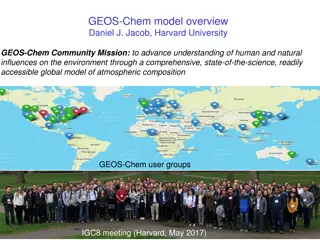
Alcohols: Structure, Classification, and Nomenclature
Explore the world of alcohols with this comprehensive guide covering the structure, classification, nomenclature, and properties of various types of alcohols. Learn about primary, secondary, and tertiary alcohols, as well as naming conventions and common names. Enhance your knowledge of alcohol chemistry and prepare for a deeper understanding of chemical reactions involving alcohols.
Download Presentation

Please find below an Image/Link to download the presentation.
The content on the website is provided AS IS for your information and personal use only. It may not be sold, licensed, or shared on other websites without obtaining consent from the author. If you encounter any issues during the download, it is possible that the publisher has removed the file from their server.
You are allowed to download the files provided on this website for personal or commercial use, subject to the condition that they are used lawfully. All files are the property of their respective owners.
The content on the website is provided AS IS for your information and personal use only. It may not be sold, licensed, or shared on other websites without obtaining consent from the author.
E N D
Presentation Transcript
ALCOHOLS 1 340 Chem 1st 1439
LearningObjectives 2 By the end of this chapter the student will: know the structure of alcohol Knew the different classes of alcohols. Knew the nomenclature of Alcohols Knew the physical Properties. Knew the acidity of Alcohols. Knew the different methods of preparation of Alcohols . Knew the chemical reactions of Alcohols 340 Chem 1st 1439
Alcohols 3 Structural Characteristic of Alcohols alcohols, a class of compounds containing the OH (hydroxyl) group. Alcohols have a hydroxyl ( OH) group bonded to a saturated carbon atom. The alcohol carbon atom may be part of a simple alkyl group, an alkenyl or alkynyl group, or the carbon atom may be a saturated carbon atom that is attached to a benzene ring: O H O H C H O H C H C H O H O H C H 3 3 2 C H C H 3 3 O H P r o p a n - 2 - o l 2 - P r o p y n o l M e t h a n o l E t h a n o l P r o p - 2 - e n - 1 - o l B e n z y l a l c o h o l 340 Chem 1st 1439
Classification of Alcohols 4 Alcohols are classified as primary, secondary, or tertiary according to the classification of the carbon that bears the functional group. The carbon atom which connected to the hydroxyl group called carbinol carbon. 340 Chem 1st 1439
5 340 Chem 1st 1439
Nomenclature of Alcohols 6 In the IUPAC system: selected the longest carbon chain that contains the -OH group as the parent alkane and numbered from the end closer to OH. change the suffix -eof the parent alkane to -ol use a number to show the location of the OH group. If there is a functional group suffix and a substituent, the functional group suffix gets the lowest possible number. For cyclic alcohols, numbering begins with the carbon bearing the OH group. If the OH group is understood to be on carbon 1 of the ring. In complex alcohols, the number for the hydroxyl group is often placed between the infix and the suffix. So the compound containing two hydroxyl groups is named as a diol, one containing three hydroxyl groups as a triol, and so on. 340 Chem 1st 1439
Compounds containing OH and C=C groups are often referred to as unsaturated alcohols.choose the chain that include them both even if this is not the longest chain. 7 In the IUPAC system, the double bond is shown by changing the infix of the parent alkane from -an- to -en- and the hydroxyl group is shown by changing the suffix of the parent alkane from -e to -ol. Numbers must be used to show the location of both the carbon-carbon double bond and the hydroxyl group. Common names derived by naming the alkyl group followed by the word alcohol. OH OH CH3CH2OH CH3OH CH3 CH3CH2CH2OH CH CH3 Common Name Methyl alcohol (Wood alcohol) Ethyl alcohol (Grain alcohol) n-Propyl alcohol (Rubbing alcohol) Propan-1-ol Allyl alcohol Isopropyl alcohol IUPAC Name Prop-2-en-1-ol Propan-2-ol Methanol Ethanol OH OH OH H2C CH2 OH Ethylene glycol OH OH Common Name n-Butyl alcohol sec-Butyl alcohol tert-Butyl alcohol Isobutyl alcohol IUPAC Name Butan-2-ol 2-Methylpropan-1-ol Ethane-1,2-diol Butan-1-ol 2-Methylpropan-2-ol 340 Chem 1st 1439
O H O H H O O H O H O H 8 I U P A C n a m e 2 - P r o p e n o l ( o r p r o p - 2 - e n - 1 - o l ) a l l y l a l c o h o l P h e n y l m e t h a n o l 2 - P r o p y n o l ( o r p r o p - 2 - y n - 1 - o l ) p r o p a r g y l a l c o h o l 1 , 2 , 3 - P r o p a n e t r i o l c o m m o n n a m e B e n z y l a l c o h o l ( G l y c e r o l , g l y c e r i n e ) O H O H O H H O O H C l C l 2 - C y c l o p e n t e n o l 1 - M e t h y l - 1 - c y c l o h e x a n l M e t h y l c y c l o h e x y l a l c o h o l O H I U P A C n a m e c o m m o n n a m e 1 , 3 - P r o p a n e d i o l 3 , 4 - D i c h l o r o - 3 - b u t e n - 2 - o l O H O H O H H2C C H O H C H3 O H O H O H C o m m o n N a m e P ro p y le n e g ly c o l c is -C y c lo h e x a n e g ly c o l 1 -C y c lo h e x y lb u ta n e -1 ,3 - d io l tra n s -C y c lo p e n ta n e -1 ,2 -d io l c is -C y c lo h e x a n e -1 ,2 -d io l P ro p a n e -1 ,2 -d io l IU P A C N a m e Note IUPAC Name Alcohol functional group suffix is ol CH3OH methanol Common Name alkyl group attached to OH, plus alcohol CH3OH methyl alcohol 340 Chem 1st 1439
Chair Conformations 9 340 Chem 1st 1439
Physical Properties of Alcohols 10 Most of the common alcohols, up to about 11 or 12 carbon atoms, are liquids at room temperature. Methanol and ethanol are free-flowing volatile liquids with characteristic fruity odors. The higher alcohols (the butanols through the decanols) are somewhat viscous, and some of the highly branched isomers are solids at room temperature. These higher alcohols have heavier but still fruity odors. Solubility Water and alcohols have similar properties because they all contain hydroxyl groups that can form hydrogen bonds. Several of the lower-molecular-weight alcohols as CH3OH,,,,C3H7OH are miscible (soluble in any proportions) with water. The solubility decreases as the alkyl group becomes larger. The number of hydroxyl groups increases so the solubility increases. 340 Chem 1st 1439
Boiling Points 11 Alcohols have much higher boiling points than comparable ethers or hydrocarbons. Alcohol molecules can associate with each other through hydrogen bonding, whereas those of ethers and hydrocarbons cannot. The boiling points increase with the increase of the number of OH groups . the boiling point decreases with increase in branching in the alkyl group. Boiling points of 1oalcohol > 2oalcohol > 3oalcohol 340 Chem 1st 1439
12 340 Chem 1st 1439
Acidity of Alcohols 13 +B H i o n a l c o h o l H + B R O a l k o x i d R O e O H +B H n e t h a n o l + B O o x i d e i o e t h Alcohols can function as both weak acids (proton donors) and weak bases (proton acceptors).A strong base can remove the hydroxyl proton to give an alkoxide ion. Alkoxide ions are strong nucleophiles and strong bases The order of acidity of various liquid alcohols generally is water > 1o>2o>3o Electron-withdrawing groups make an alcohol a stronger acid by stabilizing the conjugate base (alkoxide) The acidity decreases as the substitution on the alkyl group increases, because a more highly substituted alkyl group inhibits solvation of the alkoxide ion, decreasing the stability of the alkoxide ion and driving the dissociation equilibrium toward the left. Alcohol weaker acids than phenol and carboxylic acids The basicity of alkoxide ions increases while going from primary to tertiary. This increase in basicity occurs because the conjugate base of a weak acid is strong. 340 Chem 1st 1439
The common name of an alkoxide is constructed by deleting the final yl from the name of the alkyl group and adding the suffix oxide. In substitutive nomenclature, the suffix ate is simply added to the name of the alcohol. 14 c o m m o n : s o d iu m e t h o x id e s u b s t it u t iv e : s o d iu m e t h a n o la t e C H 3C H 2O N a 340 Chem 1st 1439
Synthesis of Alcohols 1-Synthesis of Alcohols from alkenes 15 a- By acid catalysed hydration in accordance with Markownikoff s rule. H3O+ OH + OH major minor b-Anti-Markovnikov s rule, ( Hydroboration-Oxidation) R B 2 H 6 , T H F H 2 O 2 , O H - R O H C- Dihydroxylation: synthesis of 1,2-diols from alkenes OH OH RCO3H/ H3O+ KMnO4 / OH Cold OH OH Trans-1,2 cyclopentandiol Cis-1,2 cyclopentandiol 340 Chem 1st 1439
2-Hydrolysis of alkyl halides 16 alcohol,KOH H3C C CH2 heat H CH3CH2CH2Cl dil OH- CH3CH2CH2OH CH2-Cl CH2-OH NaOH / H2O C H 3 H 2O / -O H H 3C CC l ( C H 3)3C O H+H C l C H 3 340 Chem 1st 1439
3-Reaction of Grignard reagents with aldehydes , ketones, esters and epoxides 17 Aldehyde M g C l O O M g C l O H +/ D r y e t h e r + C H 3M g C l H 3O H H O 1 H H H H H 3C H 3C C H 3 M g C l O O M g C l O H O 2 +/ D r y e t h e r + C H 3M g C l H 3O H 3C H H 3C H H 3C H H H 3C 3C C H 3 Ketone M g C l O O M g C l O H +/ D r y e t h e r + C H 3M g C l H 3O H 3C C H O H 3C H 3 H 3C H 3 C H C H 3 3 3C 3C C H 3 340 Chem 1st 1439
Ester or acid chloride ( CH3COOCH3 or CH3COCl) 18 Epoxide 340 Chem 1st 1439
4-Reduction of Aldehydes, Ketones, Acids and Esters by hydrogenation of the carbon oxygen double bond. 19 sodium borohydride (NaBH4) reduce carbonyl groups lithium aluminum hydride (LiAlH4) reduce all kind of carbonyl groups H2/ Ni or Pt or Pd or Ru reduce all double bond O H C LiAlH4, dry ether/ H2O H3C H CH3CH or NaBH4/ H2O or MeOH or H2/Pt OH O H C LiAlH4, dry ether/ H2O H3C CH3 CH3CCH3 or NaBH4/ H2O or MeOH or H2/Pt OH O H2 C LiAlH4, dry ether/ H2O H3C OH CH3COH O H2 C LiAlH4, dry ether/ H2O + CH3OH H3C OH 340 Chem 1st 1439 CH3COCH3
O O H2, Pt or Ni or Pd OR NaBH4 /H2O Li Al H4 /dry ether 20 OH O H OH OH H OR H H H H OH OH H H H 340 Chem 1st 1439
Reactions of Alcohols I.Reaction as acids (Breaking of oxygen- Hydrogen bond CO H) A. Formation of Salt (Na, K, Mg) N a o r N N a O H n o r e a c . C H 3 O H C 21 a H H 3 O N a ( s o d i u m m e t h o x i d ) N a H C O 3 n o r e a c . B. Formation of Esters (Carboxylic acid ester) O H+ O H O + C H3C O O H H eat 340 Chem 1st 1439
II. Reaction involving carbon-oxygen bond cleavage C-OH Conversion of Alcohols into Alkyl Halides 22 The order of reactivity of alcohols is 3 > 2 >1 > methyl. By using Hydrogen halides (HCl, HBr, Hl) or Phosphorus tribromide (PBr3) or Thionyl chloride (SOCl2) Z nC l2 L ucas reagent + H2O (C H3)3C C l + H C l/H2O (C H3)3C tert-butyl alcohol tert-butyl chloride (98% ) O H H C l ( c o n c d ) + O H + H 2O C l 2 5 C H B r ( c o n c d ) O H + C l r e f l u x H 3P O O H P B r3 B r 3 + 4 3 + - 1 0 t o 0 C , 4 h H C l S O C l2 S O + + + 2 p y r i d i n e ( a n o r g a n i c b a s e ) O H C l 340 Chem 1st 1439
Elimination Reactions(Dehydration of alcohols) 23 1. Formation of alkenes c o n c . H2S O4 C H3C H2O H H2C C H2 oC 1 8 0 H2S O4 + 1 8 0OC m a jo r m in o r O H 2. Ethers Formation 2 R O H + H O R H 2 S O 4 / 1 4 0 o C R O R O H O H 2 S O 4 / 1 4 0 o C + H 2 O 340 Chem 1st 1439
Oxidation of Alcohols to Carbonyl Compounds Cu/ Heat or CrO3/ Pyridine or PCC/CH2Cl2 (weak) (STRONG):KMnO4, K2Cr2O7/H3O+ , H2Cr2O7/H3O+, HNO3 24 , CrO3. HCl Pridinium Chloro chrom ate PCC = N O C u / H e a t C H3C H2O H H3C C H o r C r O3/p y r id in e o r P C C K M n O4,h e a t o r K2C r2O7, a c id O C H3C H2O H H3C C -O H O H O Cu/ Heat CH3CHCH3 H3C C-CH3 or CrO3 or KM nO4 or PCC Tertiary alcohols have no hydrogen on their hydroxyl-bearing carbon and do not undergo oxidation readily 340 Chem 1st 1439




